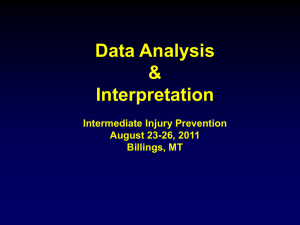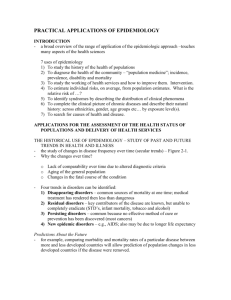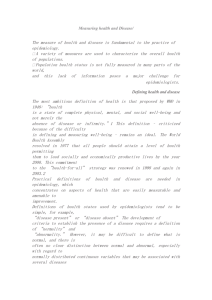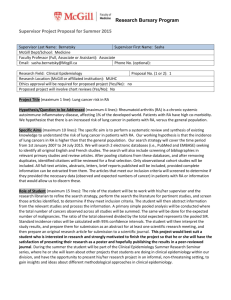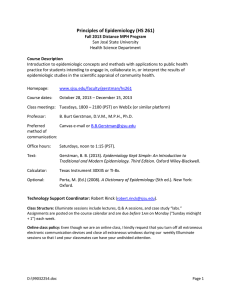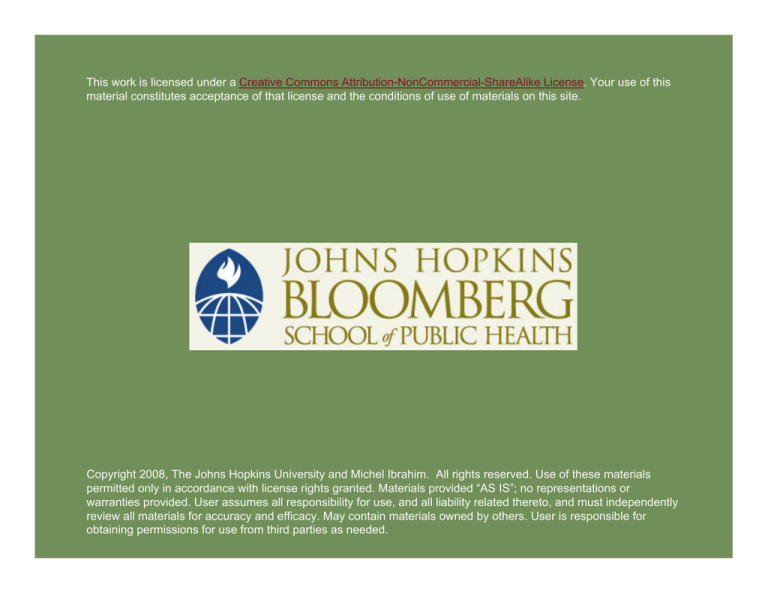
This work is licensed under a Creative Commons Attribution-NonCommercial-ShareAlike License. Your use of this
material constitutes acceptance of that license and the conditions of use of materials on this site.
Copyright 2008, The Johns Hopkins University and Michel Ibrahim. All rights reserved. Use of these materials
permitted only in accordance with license rights granted. Materials provided “AS IS”; no representations or
warranties provided. User assumes all responsibility for use, and all liability related thereto, and must independently
review all materials for accuracy and efficacy. May contain materials owned by others. User is responsible for
obtaining permissions for use from third parties as needed.
Legal, Ethical, and Policy Aspects of
Epidemiologic Investigations
Michel Ibrahim, MD, PhD, MPH
Johns Hopkins University
Section A
Introduction
Learning Objectives
Explain the general mechanisms by which the findings of
epidemiologic studies impact public policy
Discuss the elements of risk assessment
State the difference between the epidemiologic definition
and the legal definition of causality
Describe some current issues related to data confidentiality
and privacy
4
Epi in the News
Bird Flu
− Surveillance
− Modeling
− Interventions
Vioxx (NSAIDs)
− Marketed by Merck
− Increases risk of coronary artery disease
− Epi data influences legal decisions
5
Vioxx and Epidemiology
Can epidemiological evidence establish causation?
− In an individual?
− In Vioxx users generally?
What level of certainty can be reached?
6
Roles
Should epidemiologists serve as experts?
− For the defense?
− For plaintiffs?
Are there ethical concerns?
Should they be paid? how much?
7
Disparities*: PubMed “Hits” 1995–2004
800
700
600
500
400
300
200
100
0
1995 1996 1997 1998 1999 2000 2001 2002 2003 2004
*English-language publications only
8
Disparities + Epidemiology*: PubMed “Hits” 1995–2004
400
350
300
250
200
150
100
50
0
1995 1996 1997 1998 1999 2000 2001 2002 2003 2004
*English-language publications only
9
Publications
Sex, Racial Differences in the Management of Acute MI
1994–2002
90
80
70
60
White men
White wome
Black men
Black women
50
40
30
20
10
0
Reperfusion Use of aspirin Use of beta- Coronary
therapy
blockers
angiography
Vaccarino et al. NEJM. 2005,353:671-682.
11
Sex, Racial Differences in the Management of Acute MI
Conclusion:
− Although the reasons for these differences are unknown,
their persistence emphasizes the need for a continued
search for explanations so that inequities in clinical care
may be eliminated
Vaccarino et al. NEJM. 2005,353:671-682.
12
Some Paths from Epi to Policy
Diverse
Personal
Specific
Regulatory
Non-regulatory
Litigation
Societal
General
13
Impact of Epi — Today
Food choices
Obesity
Air quality
Exercise habits
Medications
Medical care
Surveillance
(bioterrorism)
14
From Data to Decision to Action
Data
Inference
Synthesis
Evaluation
Decision
Action
15
Hypothesis to Publication to Policy
Hypothesis
Study design
Funding
Study conduct
Publication
Policy
utilization
Policy
16
What Is the Role of Epidemiology in This Schema?
Epidemiologic evidence
Evidence for causal
inference
Hypothesis generation
Program evaluation
Epidemiologists
Carry out and report
research
Participate in evidence
synthesis and evaluation
Become decision makers
17
What Do Epidemiologists Publish?
18
Lung Cancer and Indoor Pollution
Source: AJE. 2005, 162:326-333.
19
Fetal Growth
Source: AJE. 2005, 162:334-344.
20
Section B
Epi to Policy: Setting Standards
NAAQS Review Process
Source: NAAQS Process Review Workgroup. Review of the Process for Setting National Ambient Air Quality
Standards. March 2006. Public Domain.
22
Example
1. Hypothesis: PM increases mortality (1990s)
2. NMMAPS (1996)
3. Funding (1996)
4. Study conduct (1996–2000)
5. Publication (2000)
6. Policy (2001–2005)
23
Air Pollution and Mortality in U.S. Cities
24
Distribution of PM and Effect on Mortality
Increase in Deaths from All Causes for Each Increase in PM10
of 10 μg/m3 (%)
Source: NEJM, 343:1742-9, 2000.
25
Epidemiologic Evidence
Source: NEJM, 343:1742-9, 2000.
26
Ozone and Short-Term Mortality in U.S. Cities
Source: JAMA. 2004;292:2372-2378.
27
What Are the Benefits and Costs of the CAA?
28
US Uranium Miners: from Cause to Compensation
Colorado Plateau During the Uranium Boom
Public Domain
29
Lung Cancer Mortality
Lung Cancer Mortality in Colorado Plateau Uranium Miners
Follow-Up Cutoff Date
Observed/Expected
1959
6/3
1962
15/4.2
1967
62/10
1974
144/29.8
1977
185/38.4
30
Original Radiation Exposure Compensation Act
Compensates miners who worked in five states, 1947–1971
For nonsmokers with lung cancer, eligible if 200 or more WLM
For smokers with lung cancer, eligible if 300+ WLM if <45 yrs
or 500+ WLM at any age
This act does not address the real problem
31
Radiation Exposure Compensation Act Amendments
32
Policy Matters for Epidemiologists
Is there a risk?
− Is the level of risk acceptable?
What level of exposure is “safe”?
How big is the problem?
− For the population?
− For the individual?
Who is affected?
What determines the exposure?
− What exposures are “healthy”?
How effective are the alternative approaches for reducing
exposure?
33
Tools for Using Epidemiologic Data
Techniques for summarizing evidence
− Meta-analysis
− Pooled analysis
− Other review methods
− Expert review
Guidelines for evidence evaluation
Risk assessment
− Integrative method for summarizing all relevant lines of
evidence
34
Questions of Cause Cause Calls for Action
Does workplace exposure to ETS cause lung cancer?
Does EMF cause brain tumors?
Does HPV cause cervical cancer?
35
Surgeon General’s Report, 2004
“The statement that an exposure
‘causes’ a disease in humans
represents a serious claim, but one
that carries with it the possibility of
prevention. Causal determinants
may also carry substantial
economic implications for society
and for those who might be held
responsible for the exposure or for
achieving its prevention.”
— Surgeon General’s Report, 2004
36
Environment and Disease: Association or Causation?
Sir Austin Bradford Hill: President’s Address, Royal Society of
Medicine, January 14, 1965
The Case for Action
Finally, in passing from association to causation I
believe in ‘real life’ we should have to consider what
flows from that decision. On scientific ground we
should do no such thing.…But in another and more
practical sense we may surely ask what is involved
in our decision. In occupational medicine our
object is usually to take action. If this be operative
cause and that be deleterious effect, then we shall
wish to intervene to abolish or reduce death or
disease.
37
Epidemiology and the Law
Epidemiology is concerned with causes of disease in groups,
not for individuals
Criteria for causality have been developed for exposuredisease associations in groups, not for individuals
Law
Epidemiology
38
Engle Jury Verdict Sheet
IN THE CIRCUIT COURT OF THE ELEVENTH
JUDICIAL CIRCUIT IN AND FOR
DADE COUNTY, FLA
GENERAL JURISDICTION DIVISION
HOWARD A. ENGLE, M.D., et al.,
Plaintiffs
v.
R.J. REYNOLDS TOBACCO COMPANY, et al.,
Defendants
Case No. 94-08273 CA-22
VERDICT FORM FOR PHASE 1
We, the jury return the following Verdict:
39
Smoking Cigarettes
Does smoking cigarettes cause one or more of the following
diseases or medical conditions?
Aortic aneurysm Yes ___No ___
Asthmatic bronchitis (as related to COPD) Yes___No___
Bladder cancer Yes ___No ___
Cerebrovascular disease (including stroke) Yes__ No__
Cervical cancer Yes ___No ___
COPD (including emphysema) Yes ___No ___
Coronary heart disease Yes ___No ___
Esophageal (throat) cancer Yes ___No ___
Infertility Yes ___No ___
40
Criteria for Causality
Epidemiology:
Plausibility, consistency,
temporality, strength,
dose-response
Law:
“Preponderance of
evidence” or “more likely than
not”
41
Lifestyle Factors: Obesity
“The culprit is an
environment which promotes
behaviors that cause
obesity.”
Genetics
Neighborhoods and schools
Modes of transportation
Local food availability
Passive
entertainment
Obesity
Low
physical
activity
Food advertising
Governmental policies
Poor
nutrition
Sources: Science 1998;280:1371-4; Med Sci Sports & Exerc 1999;31(11 Suppl):S51521; Environ Health Perspectives 2003; 111: A684-5.
42
Epidemiologists and Public Policy
Consultants
Witnesses
Testifiers
Policy makers
Advocates
43
Engaging in Policy as an Epidemiologist
Pros
− Responsibility of public
health scientists
− Assure impact of
research
− Challenging
− Rewarding
− Make friends
Cons
−Treacherous, non-science
ground
−Time-consuming
−Often unfunded
−Perceived/real conflicts
of interest
−Make enemies
44
Frequency of Policy Statements
Frequency of Policy Statements in Articles Published in
Am J Epidem iology (AJE), Epidem iology (E), Ann of Epidem iology (AE)
Policy
Statement
Yes
AJE
AE
E
Total
63 (26.7%)
12 (30%)
5 (8.3%)
80 (23.8%)
Policy Statement
All Three Journals
Clinical practice
22 (27.5%)
Public health practice
44 (55.0%)
Corporate policy
2 (2.5%)
Regulatory—legislative
1 (1.3%)
Arena not defined
10 (12.5%)
Other
1 (1.3%)
Source: adapted by CTLT from Jackson et al, Am J Public Health, 89(8):1206, 1999.
45
Some Issues Arising in the Practice of Epidemiology
Regulatory implications
Legal consequences
The epidemiologist as consultant
The epidemiologist as policy maker
Advocacy
Privacy
Confidentiality
Use of biologic samples
Conflict of interest
Informed consent
46
Backlash against Epidemiology
Motivation: the powerful societal consequences of
epidemiologic research
Guidelines for epidemiologic studies
Calls for “sound science”
Accusations of “junk science”
The standard raps
− Observational
− Not good for “weak effects”
− Cannot control other factors
47
Environment and Disease: Association or Causation?
Sir Austin Bradford Hill: President’s Address, Royal Society of
Medicine, January 14, 1965
All scientific work is incomplete—whether it
be observational or experimental. All
scientific work is liable to be upset or
modified by advancing knowledge. That
does not confer upon us a freedom to ignore
the knowledge we already have, or to
postpone the action that it appears to
demand at a given time.
From: Sander Greenland (ed), Evolution of epidemiologic ideas, annotated reading on concepts and methods.
Epidemiology Resources, Inc., 1987.
48


